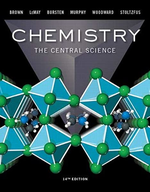?Consider the following reaction: \(\mathrm{CH}_{3} \mathrm{Br}(a q)+\mathrm{OH}^{-}(a q) \longrightarrow \mathrm{CH}_{3} \mathrm{OH}(a q)+\ma
Chapter 14, Problem 14.31(choose chapter or problem)
Consider the following reaction:
\(\mathrm{CH}_{3} \mathrm{Br}(a q)+\mathrm{OH}^{-}(a q) \longrightarrow \mathrm{CH}_{3} \mathrm{OH}(a q)+\mathrm{Br}^{-}(a q)\)
The rate law for this reaction is first order in \(\mathrm{CH}_{3} \mathrm{Br}\) and first order in \(\mathrm{OH}^{-}\). When \(\left[\mathrm{CH}_{3} \mathrm{Br}\right]\) is \(5.0 \times 10^{-3} \mathrm{M}\) and \(\left[\mathrm{OH}^{-}\right]\) is 0.050 M, the reaction rate at 298 K is 0.0432 M/s.
(a) What is the value of the rate constant?
(b) What are the units of the rate constant?
(c) What would happen to the rate if the concentration of \(\mathrm{OH}^{-}\) were tripled?
(d) What would happen to the rate if the concentration of both reactants were tripled?
Text Transcription:
CH_3Br(aq) + OH-(aq) \longrightarrow CH_3OH(aq) + Br-(aq)
CH3Br
OH-
[CH3Br]
5.0 X 10-3 M
[OH- ]
Unfortunately, we don't have that question answered yet. But you can get it answered in just 5 hours by Logging in or Becoming a subscriber.
Becoming a subscriber
Or look for another answer
